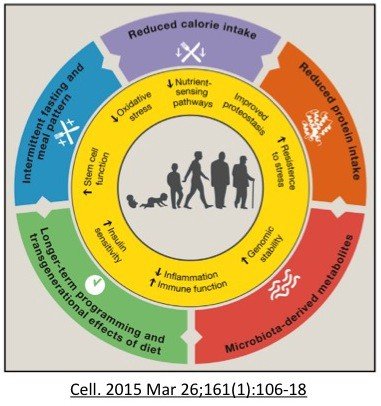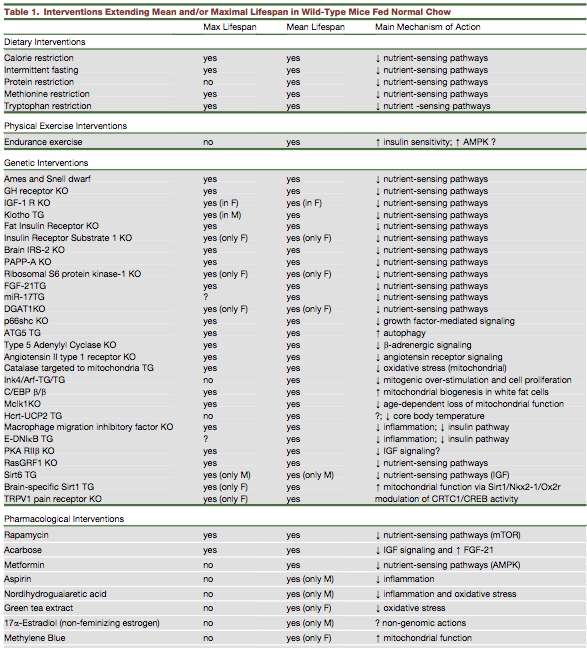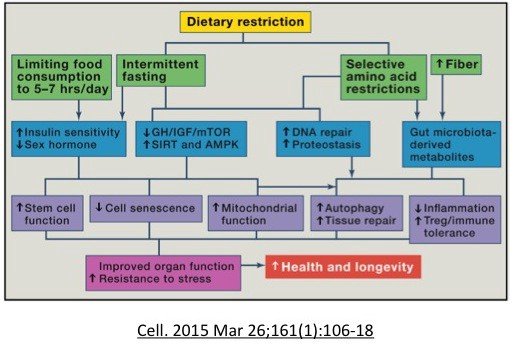Aging has always been considered an inevitable process

The table below illustrates the results from dietary, exercise, genetic and drug interventions and their main mechanism of action. Pay particular attention to the column ‘Main Mechanism of Action’. This is the best guess as to how all these different interventions may increase lifespan.




Decreased Nutrients Sensors
Compared to other dietary interventions, intermittent fasting appears to be far more powerful because alone has the ability to affect all 3 nutrient sensors simultaneously, as well as stimulate autophagy and mitophagy. mTOR is sensitive to dietary protein. Insulin is sensitive to proteins and carbohydrates. So eating a pure fat diet (not realistic) may lower mTOR and insulin, but will not be able to raise AMPK, since that senses the energy status of the cells. If you are eat a very high fat diet (ketogenic) your body will still be able to metabolize this to energy — generating ATP and lowering AMPK. Only 2 of the 3 nutrient sensing pathways have been alerted. Only complete restriction of nutrients will have this effect (ie. fasting).
[caption id=”attachment_7879" align=”alignright” width=”320"]
Petri dish[/caption]
Theoretically, eating less frequently may significantly improve health. Most omnivorous mammals eat only intermittently, since we tend not to live on a Petri dish where nutrients are constantly available. Carnivores like lions and tigers often eat once a week or less. Ancestral humans tend to eat intermittently depending on food availability. Being able to function at a high level, both physically and intellectually, for extended fasting periods was fundamentally important to survival. This explains our well developed systems for food storage (glycogen in the liver, and body fat), and also our highly conserved nutrient sensors to slow cellular growth during a period of low nutrient availability.
Things changed somewhat with the agricultural revolution approximately 10,000 years ago. From a hunter-gatherer society, agriculture allowed populations of humans to stay in one area and resulted in more stable food availability. However, there would still be seasonal variation and possibly long weeks or months where food is less available. There would also be shorter periods of time, days — weeks, where food was restricted.
Most humans ate between 2–3 times per day. Without light, it would be difficult to eat a ‘midnight’ snack in the pitch blackness. So early humans still followed a tradition of a long overnight fasting period — hence the term ‘break-fast’.
Different nutrient sensors are sensitive to different time durations. That is, it would be useful for our body to know whether nutrients were restricted in the short term (overnight) in the medium durations (days) or long durations (weeks — months, seasons). You can see that our human body has evolved exactly those same capabilities in our nutrient sensors.
Insulin (short term)
mTOR (days)
AMPK (weeks)

We can begin to regain some of our lost ancient wisdom by following the ancient food tradition of taking a break from eating once in a while. Give yourself a chance to digest the food you’ve eaten. Intermittent fasting. Boom.
Health Longevity Diet Wellness
https://medium.com/personal-growth/longevity-and-diet-9b5011afc22
Hi! I am a robot. I just upvoted you! I found similar content that readers might be interested in:
https://medium.com/personal-growth/longevity-and-diet-9b5011afc22
thanx for the valuable information. I really helps in maintaining balanced health. I will try to follow this